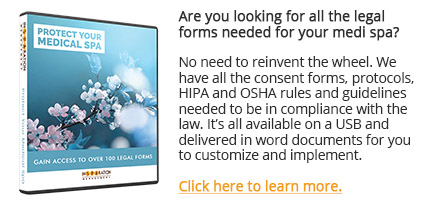Top 10 Ways To Keep Your Spa or
Medical Practice in Compliance
One of the biggest concerns currently facing the medical aesthetic industry is the lack of knowledge of the regulations relating to the industry. This is alarming because aesthetics is one of the fastest growing fields in medicine. According to a study from the American Society of Plastic Surgeons, there were over 13 billion surgical and non-surgical cosmetic procedures performed last year. Of that, 42% were non-surgical. The top five non-surgical procedures were:
- Botulinum toxin – 4.2m
- Soft tissue fillers – 2.1m
- Laser hair removal – 1.1m
- Chemical peel – 600k
- Microdermabrasion – 500k
These non-surgical procedures are most often performed independently by an allied health professional or delegated to an allied health professional to perform. There are also instances where the performance of the procedure is delegated to an aesthetician. Yet – in many circumstances, the delegation of the procedure is improper because the performance of the procedure is outside the scope of the allied health professional’s license.
Keeping your medical practice or medical spa in compliance with the ever-changing regulations is a difficult task. But, it is important – and indeed – the practitioner’s responsibility to know the local, state and federal regulations governing their practice. This article is listing the top 10 areas to focus on in your practice, but by no means is it all inclusive.
1. State Licensure Requirements: The types of services offered at a spa or medical spa will likely affect licensure requirements that apply. Most states consider many of the services provided in spas as the practice of medicine, including various laser treatments. The degree to which the treatments can be delegated to unlicensed health care providers varies, and state laws regarding scope of practice and required supervision have to be considered. There’s also the scope of practice-described procedures, actions and processes that a healthcare practitioner is permitted to undertake in keeping with the terms of their professional license.
The scope of practice is limited to that which the law allows for specific education and experience, and specific demonstrated competency. Each state has different regulations relating to who can inject or perform laser treatments. For instance, in New York state, an aesthetician is permitted to perform Laser Hair Removal while in neighboring New Jersey, an aesthetician is not permitted to operate any form of laser. It is imperative that you know your state’s regulatory scheme. Practitioners who delegate tasks that are outside of the delegatee’s scope of practice could face civil penalties and criminal charges in aiding and abetting the unlicensed practice of medicine. The delegatee would also face prosecution.
Importantly, any practitioner who decides to delegate a task must be able to perform the same tasks themselves. You cannot delegate a task to your team that you do not know how to perform.
2. Supervision Requirements: Once you have obtained information relative to what tasks can be delegated to what staff, you must be compliant with the supervision requirements of that staff. For instance, do you need to examine the patient before delegating? Do you need to be on site or have direct staff supervision? There are also restrictions on how many physician assistants a physician can supervise at any given time. Many states require that you have a written practice agreement with the physician assistant. If you are acting as a collaborating physician for a nurse practitioner, do you have a written collaborative agreement? As of 2016, the only states that do not require a written collaborative agreement are (AK, AZ, CO, D.C., HI, ID, IA, ME, MT, NE, NH, NM, ND, OE, RI, VT, WA and WY).
Failure to have proper collaborative or practice agreements in place can lead to sanctions against both the physician and the allied health professional.
3. Training Requirements: The lack of proper training is increasingly an issue. Most practitioners believe that having their staff trained by the laser manufacturer is enough for the staff to operate a laser. However, this is not the case. All licensing boards require specific training in an area before being permitted to practice. What is often the problem is that medical schools, physician assistant programs and nursing programs have not kept up with technology and do not offer student training with lasers or laser safety. It is important to seek out a formal educational program that provides education related to the use of laser technologies for medical purposes, including laser safety standards of the American National Standards Institute.
4. Medical Director Rules: The term medical director must be used with caution. A medical director is generally described as a person who performs quality assurance review for a medical facility. Acting as a medical director or lending your name as a medical director for a medical spa that you have no real involvement with is improper in most jurisdictions. Another important consideration is the compensation terms. Physicians cannot be paid for medical services that they did not perform.
5. Insurance: Because medical procedures are being performed, every practitioner must review their current medical malpractice policy and make sure they are covered for the use of lasers in their practice. I have reviewed numerous insurance policies that have excluded certain types of lasers from the policy, unbeknownst to the practitioner. If you add a new device to the practice, inform the carrier. The policy should also provide coverage for all staff as well as to make sure that staff has their own malpractice coverage.
6. Advertising Restrictions: The line between promoting effective procedures/products and misleading advertising may be blurry. State consumer protection laws, the Federal Trade Commission (“FTC”) and healthcare regulations will provide insight into the parameters that must be placed when advertising —whether it be via radio, internet, television or social media ads. For instance, many State medical board’s prohibit a physician from using testimonials. The FTC governs commercial advertising and requires all forms of physician advertising in any medium to be explicitly and implicitly truthful and not misleading. The physician must have a reasonable basis to make claims that are either: i) facts known to the advertiser, and ii) those which a reasonable, prudent advertiser should have discovered:
So what tips do you need to know so that your advertisement is not deemed to be deceptive or misleading?
- All information must be accurate – you cannot omit information that may be harmful.
- Do not create false or unjustified expectations.
- Avoid terms such as “top,” “world-famous,” “world-class,” or even “pioneer.” Usually are misleading and designed to attract vulnerable patients.
- Avoid statements that rank your competence or the quality of medical services because they are usually not factually supportable.
- If you plan on using paid advertisements, it must be clearly stated that the advertisement is paid.
- Avoid calling yourself a specialist if you aren’t a specialist. It is impermissible to indicate that you have a subspecialty where no subspecialty exists.
- Take precaution when advertising experimental procedures or procedures that have never been proved to result in the desired outcome.
- Do not make a guarantee of results.
- Detail fee structures or costs for procedures to avoid inaccurate assumptions.
- Make sure that there are disclaimers with any before and after images.
7. Corporate Practice of Medicine: When forming a relationship with a licensed physician, non-physicians must be aware of the corporate practice of medicine legal doctrine, as well as other ethical considerations. These considerations may help dictate the appropriate ownership structure. The corporate practice of medicine prohibits physicians or other health care professionals from being employed by a business or non-health care professional. This frequently occurs in situations where a medical spa is owned by a non-physician but want to hire the physician to perform medical services or act as their “medical director.” In corporate practice of medicine states, this type of arrangement is strictly prohibited.
8. Fee Splitting and Commission Based Compensation: Fee splitting statutes frequently prohibit physicians from dividing or sharing with non-physicians fees or compensation charged for services performed – this includes payment to their team. Compensation arrangements should avoid percentages or bonuses based on volume.
9. Patient Charts and Other Documents: Maintaining the appropriate documentation is necessary not only for good business practices, but also for when a state agency or licensing board subpoenas or audits the documentation being maintained by the medical director or other licensed personnel. When it comes to adverse outcomes, medical practices and spas will want to have their files appropriately documented in the event that litigation transpires. All practices should have standard operating procedures and protocols in place that detail, among other things, what procedures are permitted to be performed and by whom, where records are kept, how medication is stored and discarded, who to contact in an emergency, and what emergency supplies are on hand.
10. Compliance with OSHA: OSHA requirements are often overlooked. OSHA has specific regulations in place that require the identity of a laser safety officer, blood borne pathogen training and protocols, and keeping the material safety data sheets for all chemicals (including cleaning products) and medications used in the practice or spa. OSHA fines can be substantial depending on the degree of the violation, so knowing the OSHA guidelines is critical.
Written by Allison Avila, Attorney













